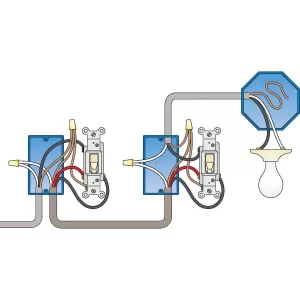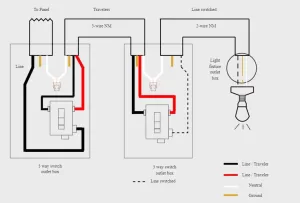
Mastering the Art of 3-Way Switch Wiring: A Step-by-Step Guide
November 28 2023  1569
1569
Inquiry
Global electronic component supplier AMPHEO PTY LTD: Rich inventory for one-stop shopping. Inquire easily, and receive fast, customized solutions and quotes.
QUICK RFQ
ADD TO RFQ LIST
When it comes to electrical wiring, 3-way switches are special because they allow two different places to control one light fixture. Even though they have simple functionality, those who are unfamiliar with wiring may find it intimidating. In this blog, we will unravel the mysteries of 3-way switch wiring, providing a step-by-step approach to mastering this essential electrical skill.
What is a 3-Way Switch?

3-Way Switch Wiring Diagrams

- Common Terminal: Usually denoted by a black wire, every 3-way switch has a common terminal. The hot wire coming from the power source is attached to this terminal.
- Traveler Terminals: The two traveler terminals on a 3-way switch are usually denoted by red and blue wires. Together, the two switches can control the light fixture thanks to the connections made between these terminals.
- Hot Wire to Light Fixture: A hot wire connects one of the traveler terminals to the light fixture. It is commonly recognized as a red or black wire.
How are 3-way switches wired?
- Turn Off the Power: Prior to working on any electrical wiring, always cut the circuit's power.
- Identify the Power Source: Find the fuse or circuit breaker that regulates the light fixture, then flip it to the "off" position.
- Remove Existing Switches and Cover Plates: Take out the old switches and cover plates carefully, making sure to note the wire connections.
- Identify Traveler Wires: To prevent confusion during the reconnection process, label the traveler wires (red and blue).
- Connect Common Terminal: Attach one of the 3-way switches' common terminals to the black wire coming from the power source.
- Connect Traveler Wires: Attach the two 3-way switches' traveler terminals to the remaining traveler wires, which are blue and red.
- Connect Hot Wire to Light Fixture: Attach the hot wire on the light fixture to one of the traveler terminals.
- Connect Neutral and Ground Wires: Join the cable's neutral wire to the light fixture's neutral wire. Attach the cable's ground wire to the light fixture's ground wire.
- Secure Wire Connections: To firmly fasten all wire connections, use wire nuts.
- Install cover plates and switches: Put in place the cover plates for the three-way switches.
- Turn on Power and Test: Restart the circuit's electricity supply and check how the three-way switch functions. Either switch location should be able to turn on and off the light fixture.
Video related to How to wire a 3-way switch
Essential Precautions for 3-Way Switch Wiring
- Always Turn Off Power: At the main breaker panel, always turn off the power to the circuit before working on any electrical wiring. To avoid electrical shock or other dangers, this is essential.
- Utilize Proper Tools and Equipment: To ensure secure and appropriate wiring connections, use the right tools, such as electrical tape, screwdrivers, wire cutters, pliers, and strippers.
- Handle Wires with Care: Handle wires carefully, especially the ones that are exposed. To prevent electrical shock, keep your hands away from exposed wires and frayed insulation.
- Secure Wire Connections: To ensure that wire connections are securely fastened, use wire nuts or other recognized connectors. The possibility of overheating and possible fires can be increased by loose connections.
- Ground Electrical Equipment: To reduce the chance of electrical shock and maintain safety, ground all electrical equipment, such as switches and light fixtures, appropriately.
- Seek Professional Assistance: See a licensed electrician if you have any questions regarding any aspect of the wiring for 3-way switches. They are qualified and experienced to manage electrical work in a safe and efficient manner.
Troubleshooting 3-Way Switch Problems
- Light Not Turning On or Off: If the light does not turn on or off, make sure the wire connections are tight and secure. Examine the bulbs for wear or damage. Make sure the breaker panel's power is turned on.
- Light Flickering: Light flickering can be caused by loose wire connections. Verify and tighten every connection made by wire. Replace the light fixture if the issue continues.
- Light Stuck On: The light may stay on if there is a malfunctioning switch or if a hot wire is attached to the incorrect terminal. Verify the switch's functionality and make sure the wiring connections are made correctly. Replace the switch if the issue continues.
- Light Stuck Off: The light may not turn on due to a broken switch or a loose connection. Tighten any loose wire connections and check the switch's functionality. In case the issue continues, swap out the switch.
Where are 3-Way Switches Used?
In both residential and commercial buildings, 3-way switches are frequently used to control lighting from two separate locations. They are frequently found in hallways, stairwells, and large rooms where there are several entrances and it is practical to have control over the same light or group of lights from several locations. For instance, a three-way switch arrangement enables you to control a light from either end of a lengthy hallway or from the top and bottom of a staircase. This makes it easy and flexible to control the lighting in different parts of a building.Conclusion
Understanding the complexities of 3-way switch wiring will enable you to conveniently and precisely control the lighting in your home. Effective installation and maintenance of 3-way switch systems can be achieved by following the step-by-step instructions, taking safety precautions, and troubleshooting common issues. This will ensure seamless lighting control from multiple locations.Populer Posts
CX10S-CCB0BD-P-A-DK00000
Advanced Energy
CX10S-BCDCDG-P-A-DK00000
Advanced Energy
CX10S-BCADCC-P-A-DK00000
Advanced Energy
CX10S-BAAA0D-P-A-DK00000
Advanced Energy
CX10S-D00HCB-P-A-DK00000
Advanced Energy
CX10S-BBDCBD-P-A-DK00000
Advanced Energy
CX10S-BBDCBC-P-A-DK00000
Advanced Energy
CX10S-C0GCDH-P-A-DK00000
Advanced Energy
CX10S-CAGHCD-P-A-DK00000
Advanced Energy
CX10S-BCGH00-P-A-DK00000
Advanced Energy
CX10S-CAC0CB-P-A-DK00000
Advanced Energy
CX10S-CG0HHD-P-A-DK00000
Advanced Energy
